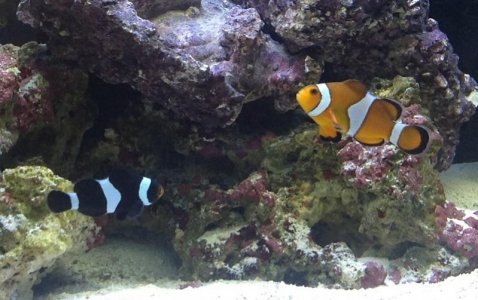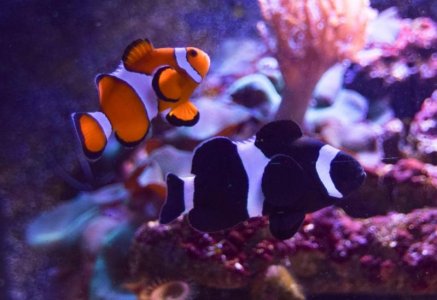seleeene
New member
Hi all,
I'm having trouble identifying the true sex of my ocellaris clowns in my 29g biocube. I've had an orange ocellaris clown for almost 10 years which was kept singly for the first 5 years (assuming it was female for that time). Then, 5 years ago I bought a much smaller black ocellaris clown (assuming it would remain male) that paired with the larger orange clown. The orange clown remained larger and more dominant/aggressive and the black clown remained smaller/submissive for 3 years after the initial pairing UNTIL the smaller black clown grew 3x its size and is now the more dominate/aggressive clown. The previously assumed female orange clwon now only displays submissive behaviour even though it was the dominate fish. This behaviour change and size difference began when I had to move from a 8gal --> 14 gal after my tank accidentally fell on the floor and was literally in pieces. The fish were probably electrically shocked from the equipment getting wet before they were rescued.
My question is, do I have a pair of two sexually mature females but only one displays female behaviour? Or is it possible for a mature female clown to revert back to a male? I've never heard of the latter being possible so I'm wondering what everyone has to say about this.
Many Thanks! :hmm5:
Photo 1 from 2008:

Photo 2 from 2016:

I'm having trouble identifying the true sex of my ocellaris clowns in my 29g biocube. I've had an orange ocellaris clown for almost 10 years which was kept singly for the first 5 years (assuming it was female for that time). Then, 5 years ago I bought a much smaller black ocellaris clown (assuming it would remain male) that paired with the larger orange clown. The orange clown remained larger and more dominant/aggressive and the black clown remained smaller/submissive for 3 years after the initial pairing UNTIL the smaller black clown grew 3x its size and is now the more dominate/aggressive clown. The previously assumed female orange clwon now only displays submissive behaviour even though it was the dominate fish. This behaviour change and size difference began when I had to move from a 8gal --> 14 gal after my tank accidentally fell on the floor and was literally in pieces. The fish were probably electrically shocked from the equipment getting wet before they were rescued.
My question is, do I have a pair of two sexually mature females but only one displays female behaviour? Or is it possible for a mature female clown to revert back to a male? I've never heard of the latter being possible so I'm wondering what everyone has to say about this.
Many Thanks! :hmm5:
Photo 1 from 2008:

Photo 2 from 2016:

